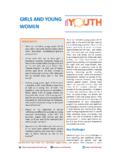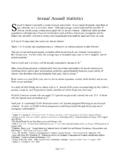Transcription of Gender equality and women’s rights in the post …
1 Element 3, PAPER 1. OECD AND POST-2015 REFLECTIONS Gender equality and women 's rights in the post-2015. agenda: a foundation for sustainable development G. ender equality and women 's rights are key to addressing the unfinished business of the Millennium development Goals (MDGs) and accelerating global development beyond 2015. Gender equality . Gender equality matters in its own right, and as a prerequisite for the health and development of families and societies, and a driver of economic growth. The post-2015 framework should 1) retain a strong, stand-alone goal on Gender equality and women 's empowerment, as recommended by the UN High Level Panel on the Post-2015. development Agenda (HLP); and 2) include Gender -specific targets and indicators in the other goals. A strong post-2015 framework will take a holistic view of Gender inequalities: 1) addressing girls' completion of a quality education, 2) women 's economic empowerment, 3) universal access to sexual and reproductive health and rights , 4) ending violence against women and girls, 5) women 's voice, leadership and influence, 6) women 's participation in peace and security, 7) women 's contributions to environmental sustainability.
2 The new framework will need to confront the discriminatory social norms and practices that underlie Gender inequality, such as early marriage or tolerance of violence against women . Targets and indicators on Gender equality act as a powerful stimulus for action. When girls and women are visible in data collection and reporting, governments and donors invest more in Gender equality . There is an urgent need for ongoing investment in statistical capacity building and monitoring to improve the measurement of Gender equality indicators and the collection of data disaggregated by sex. Why focus on Gender equality in the post-2015 agenda? There is no chance of making poverty history without significant and rapid improvements to the lives of women and girls in all countries. Millennium development Goal 3 to promote Gender equality and empower women signalled global recognition that this is both an important development goal in itself, and a key to the success of all the other goals. The post-2015 framework presents a unique opportunity to build on the achievements of the Millennium development Goals (MDGs), while also addressing the dimensions that lag behind.
3 It is time to act now to increase both the political will and the resources to achieve full and lasting Gender equality , women 's empowerment and women 's rights . Reviewing the Millennium development Goal on Gender equality Progress towards the Millennium development Goal 3 (MDG 3; see Box 1) target has been mixed. Although Gender equality in access to primary schooling has almost been achieved in most countries, there are still 68 countries where the disparity remains significant. Girls' enrolment in basic education is lowest in sub Saharan Africa, Oceania and the Middle East. Moreover, Gender disparities widen in secondary and tertiary education in most developing countries. While more women have entered the workforce in recent decades, they typically work at the informal end of labour markets with poor earnings and insecure conditions. This increases the risk of poverty across their lifecycle and makes it less likely that they will be covered by social protection schemes and benefits such as pensions.
4 women still face a Gender pay gap, segregation in occupations and glass ceilings, with over-representation in low-paying jobs and under-representation in senior positions. Around 800. women die every day from preventable causes during pregnancy and childbirth, making MDG 5 on maternal health the most off track MDG goal in 2013. Box 1. Millennium development Goal 3. MDG 3: To promote Gender equality and empower women . Target: Eliminate Gender disparity in primary and secondary education, preferably by 2005, and in all levels of education no later than 2015. Indicators: ratios of girls to boys in primary, secondary and tertiary education share of women in wage employment in the non-agricultural sector proportion of seats held by women in national parliaments. Source: UN (2013), We Can End Poverty 2015: Millennium development Goals, UN website, Despite progress in some areas, the OECD report Closing the Gender Gap: Act Now (2012a) found that Gender equality and women 's empowerment remain unfinished business across all countries.
5 Its key findings were: Better Gender equality in education boosts female labour force participation and economic growth. In many low-income countries, young women are less likely than young men to be in paid work, education or training. They are also less likely to complete secondary education. Schools need to be made safer and more affordable for girls. women in informal employment tend to be over-represented among domestic and family workers. They are at greater risk of poverty and have limited prospects of upward mobility. Occupational segregation has not improved and Gender pay gaps persist. 2 Gender equality AND women 'S rights IN THE POST-2015 AGENDA: a foundation for sustainable development . Cultural barriers need to be challenged, as well as the stereotyping of women 's roles in society, business and the public sector. women entrepreneurs remain a minority in all countries. Enterprises owned by women are significantly smaller and less well represented in capital-intensive sectors.
6 In developing economies, women are much more likely to own small enterprises in the informal sector than the formal one. Ensuring equal access to finance for male and female entrepreneurs is a priority. In most countries, women are still under-represented in parliaments, judicial systems, executive branch of governments, and senior civil service even in countries where they account for the majority of public sector workers. A stand-alone goal on Gender equality and women 's rights Eminent persons recognised the need to keep Gender equality as a stand-alone goal in the UN. Secretary General's High Level Panel on the Post-2015 development Agenda (HLP, 2013). They also proposed national targets on eliminating violence against women and girls; ending early marriage;. ensuring access, ownership and inheritance of assets; and eliminating discrimination against women in Box 2. Actions that will make a difference political, economic and public life. To address the unfinished business of Gender equality and women 's empowerment, it is essential to put women and girls A strong, stand-alone goal is needed front and centre of the post-2015 framework by: to tackle the Gender inequalities that remain widespread and persistent Retaining a stand-alone Gender equality and women 's across the world and which empowerment goal and addressing Gender equality throughout the post-2015 development agenda.
7 This leave women disproportionately twin-track approach has wide-ranging support from represented amongst the poorest governments, the United Nations and civil society (HLP, and most marginalised people. A 2013; UN women , 2013; GADN, 2013). stand-alone Gender equality goal is Confronting and transforming the social norms and also strategically important in order institutions that discriminate against women and girls, to remove barriers to progress in such as the acceptability of domestic violence. the other goals. This paper does not attempt to identify specific targets Gathering and using high quality data to monitor progress and build evidence about what works. and indicators, but recommends that a stand-alone Gender equality Tracking governments' expenditure and the proportion of goal should have a limited number all development co-operation focused on achieving Gender of targets, without which Gender equality and women 's empowerment. equality and women 's empowerment cannot be achieved.
8 The proposed targets for ending early marriage and stopping violence against women and girls are good examples (see the section on measurement and data below). 3. Gender -specific targets across all goals An effective post-2015 framework must prioritise Gender equality across other goals through concrete, Gender -specific targets and indicators, including in the areas of poverty, education, health, jobs and livelihoods, food security, environmental and energy sustainability, and stable and peaceful societies. None of these development goals will be achieved without addressing Gender inequality. The UN's HLP report recognises this need for integration across the goals, both to challenge the underlying Gender inequalities that impede women 's progress and to intensify the multiplier effect of Gender equality on achieving other development goals. For example, greater Gender equality in education allows countries to reap the economic benefits of female human capital, which in turn supports overall economic growth.
9 There is strong evidence that closing Gender gaps accelerates progress towards other development goals. Analysis based on the OECD Social Institutions and Gender Index (SIGI) data finds that lower levels of discrimination against women are linked to better outcomes in several areas, including educational attainment, child health and food security. For example, where women have a more equal status in the family, children are more likely to complete primary school, even when allowing for differences in country income level, urbanisation and the fertility rate. Where women have greater physical integrity (control over their own bodies), child health outcomes improve. Countries with the greatest restrictions on women 's physical integrity for example, where there are high levels of violence against women , and where women lack the power to make choices about their sexual and reproductive lives have an average infant mortality rate more than three times the rate of countries with low levels of restrictions (Figure 1).
10 Similarly, countries where women lack any right to own land have on average 60% more malnourished children. Figure 1: Child mortality rates are higher in countries where women 's physical integrity is highly restricted1. Infant Mortality rate, per 1,000 live births (predicted values). Low Low-Moderate Moderate Moderate-High High Level of restriction, SIGI 2012 Restricted Physical Integrity quintiles Source: OECD (2012c), Tackling the root causes of Gender inequalities in the post-2015 development agenda , submission to the global thematic consultation on addressing inequalities, OECD Publishing, Paris. 4 Gender equality AND women 'S rights IN THE POST-2015 AGENDA: a foundation for sustainable development . Measurement and data A strong focus on Gender equality in the post-2015 framework would incentivise better tracking of progress towards this goal, thereby increasing demand for Gender equality data and statistical capacity building. These are essential to fill the significant remaining gaps in data availability, comparability, quality and coverage on vital Gender equality issues.
















